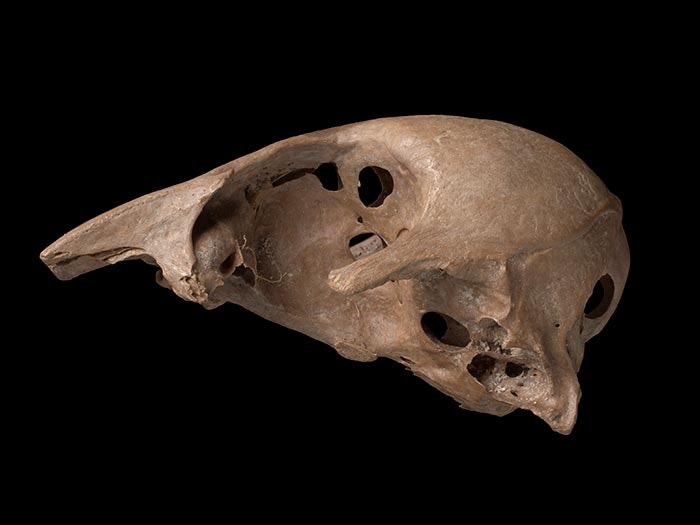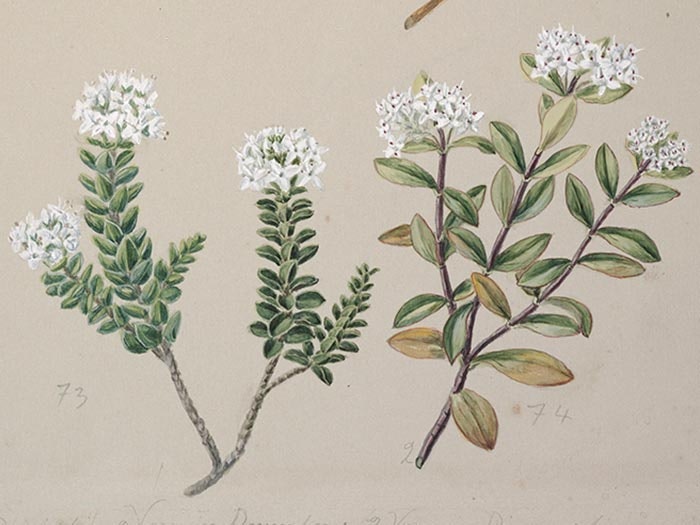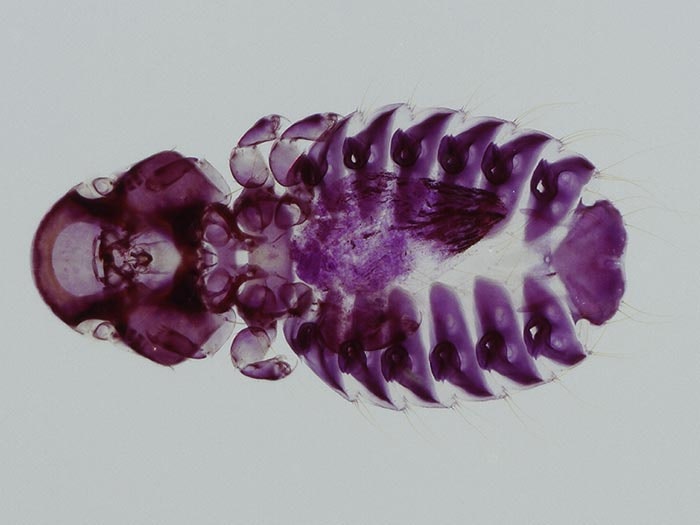
Tuhinga 15, 2004
EAN 11734337
Jump to:
trnL intron variation in New Zealand taxa of the Asplenium obtusatum Chloroplast Group
Barava: land title deeds in fossil shell from the western Solomon Islands
Geographic variation in Hebe macrantha (Plantaginaceae): morphology and flavonoid chemistry
Lectotypification of names of New Zealand members of Veronica and Hebe (Plantaginaceae)
The Holocene fossil waterfowl fauna of Lake Poukawa, North Island, New Zealand
First record of an anomalous mullet fish (Mugil cephalus) from New Zealand
trnL intron variation in New Zealand taxa of the Asplenium obtusatum Chloroplast Group
Leon R Perrie and Patrick J Brownsey
ABSTRACT: Previous attempts to distinguish the tetraploid ferns Asplenium oblongifolium and A. obtusatum subsp. obtusatum with chloroplast DNA sequence data have been unsuccessful, although they have implicated one or other of these taxa as the chloroplast parents of the putative allopolyploids A. lyallii and A. scleroprium. Here we report new chloroplast DNA sequence data from the trnL intron, which are able to distinguish genetically the samples of A. oblongifolium and A. obtusatum subsp. obtusatum investigated. However, these data are insufficient to resolve which of the tetraploids were involved in the allopolyploid events producing A. lyallii and A. scleroprium.
trnL intron variation in New Zealand taxa of the Asplenium obtusatum Chloroplast Group (172.18 KB)
Notes on the genus Phycosoma Cambridge, 1879, senior synonym of Trigonobothrys Simon, 1889 (Theridiidae: Araneae)
Brian M Fitzgerald and Philip J Sirvid
ABSTRACT: Phycosoma Cambridge, 1879, is confirmed as the senior synonym of Trigonobothrys Simon, 1889. Additionally, an examination of specimens of several species and illustrations of others has resulted in the transfer of Dipoenaalta Keyserling, 1886, D. lineatipes Bryant, 1933, D. jamesi Roberts, 1979, D. menustya Roberts, 1983, and Theridion inornatum Cambridge, 1861 toPhycosoma. A list of all the species included in Phycosoma is given. Lastly, on the basis of genitalic characters, two species originally described by Hickman (1951) as Trigonobothrys aculeatus and T. setosus are presently retained in the genus Dipoena Thorell, 1869, as placed by Levi & Levi (1962).
Notes on the genus Phycosoma Cambridge, 1879, senior synonym of Trigonobothrys Simon, 1889 (Theridiidae: Araneae) (149.45 KB)
Designation of a lectotype for Docophorus atlanticus Kellogg, 1914 (Insecta: Phthiraptera: Philopteridae)
Ricardo L Palma
ABSTRACT: Upon the rediscovery of seven syntypes in the collection of the United States National Museum of Natural History, a male lectotype for the louse taxon Docophorus atlanticus Kellogg, 1914, is designated from the syntype series. Detailed study of the rediscovered syntypes showed that two species (Saemundssonia cephalus [Denny, 1842] and an unidentifiable species ofSaemundssonia) were included in the series.
Designation of a lectotype for Docophorus atlanticus Kellogg, 1914 (Insecta: Phthiraptera: Philopteridae) (149.45 KB)
Barava: land title deeds in fossil shell from the western Solomon Islands
Rhys Richards and Kenneth Roga
ABSTRACT: Following fieldwork in the Solomon Islands and the tracing of residual traditional knowledge in Ranongga Island, a large fretworked Tridacnashell plaque, known as a ‘barava’, held in the Museum of New Zealand Te Papa Tongarewa collection, can now be reinterpreted as originally being a land title deed. This review proposes a revision of the generic term ‘barava’ to cover a wide range of Tridacna shell plaques, and seeks to restore something of its original social context and glory to the Te Papa plaque.
Barava: land title deeds in fossil shell from the western Solomon Islands (300.27 KB)
Geographic variation in Hebe macrantha (Plantaginaceae): morphology and flavonoid chemistry
Michael J Bayly, Alison V Kellow, Rebecca Ansell, Kevin A. Mitchell, and Kenneth R. Markham
ABSTRACT: This paper investigates geographic variation in Hebe macrantha,endemic to mountains of South Island, New Zealand, with the aim of assessing the attributes, distribution, and appropriate taxonomic status of its two previously described varieties, the validity and circumscriptions of which have been questioned by some taxonomists. Morphometric analyses support the existence of two morphologically distinguishable entities that equate with previous circumscriptions of var. macrantha and var. brachyphylla, the continued recognition of which (at variety rank) is recommended. Variety brachyphyllaoccurs in the north of the species’ geographic range, from the Anatoki Range, northwest Nelson, to the Hanmer Range, north Canterbury. Variety macrantha is geographically more widespread and morphologically more variable, occurring in the south of the species’ range, south and west from Mt Haast (southwest Nelson) and Lewis Pass (south Nelson/north Canterbury), as well as at Lake Tennyson (southeast Nelson), the only locality at which specimens assigned to both varieties occur. The two varieties are morphologically most similar at localities close to their geographic interface. Patterns of variation in leaf flavonoids neither strongly support nor contradict recognition of the two varieties. Analysed samples share a similar and, within Hebe, distinctive flavonoid profile, and the distribution of two flavonoid glycosides is partly correlated with the morphological circumscription of varieties (the correlation is incomplete in samples taken near the geographic interface of varieties). A distribution map and a table of key morphological differences between varieties are provided.
Geographic variation in Hebe macrantha (Plantaginaceae): morphology and flavonoid chemistry (303.60 KB)
Lectotypification of names of New Zealand members of Veronica and Hebe (Plantaginaceae)
Michael J Bayly and Alison V Kellow
ABSTRACT: This paper, a further contribution toward a revised classification ofHebe, lectotypifies 20 names in Veronica and Hebe from New Zealand. These names are: Veronica subg. Koromika J.B.Armstr., V. subg. PseudoveronicaJ.B.Armstr., V. buchananii Hook.f., V. buxifolia var. patens Cheeseman, V.cupressoides var. variabilis N.E.Br., V. diosmifolia A.Cunn., V. dorrien-smithiiCockayne, V. lewisii J.B.Armstr., V. lycopodioides Hook.f., V. macroura var. dubiaCheeseman, V. menziesii Benth., V. obovata Kirk, V. parviflora var. phillyreaefoliaHook.f., V. pinguifolia Hook.f., V. salicifolia G.Forst., V. stricta Benth., V. tumidaKirk, Hebe brachysiphon Summerh., H. corriganii Carse, H. corymbosa G. Simpson.
Lectotypification of names of New Zealand members of Veronica and Hebe (Plantaginaceae) (665.31 KB)
New Zealand harvestmen of the subfamily Megalopsalidinae (Opiliones: Monoscutidae) – the genus Pantopsalis
Christopher K Taylor
ABSTRACT: The genus Pantopsalis Simon, 1879, and its constituent species are redescribed. A number of species of Pantopsalis show polymorphism in the males, with one form possessing long, slender chelicerae, and the other shorter, stouter chelicerae. These forms have been mistaken in the past for separate species. A new species, Pantopsalis phocator, is described from Codfish Island.Megalopsalis luna Forster, 1944 is transferred to Pantopsalis. Pantopsalis distincta Forster, 1964, P. wattsi Hogg, 1920, and P. grayi Hogg, 1920 are transferred to Megalopsalis Roewer, 1923. Pantopsalis nigripalpis
nigripalpis Pocock, 1902, P. nigripalpis spiculosa Pocock, 1902, and P. jenningsiPocock, 1903 are synonymised with P. albipalpis Pocock, 1902. Pantopsalis trippiPocock, 1903 is synonymised with P. coronata Pocock, 1903, and P. mila Forster, 1964 is synonymised with P. johnsi Forster, 1964. A list of species described to date from New Zealand and Australia in the Megalopsalidinae is given as an appendix.
New Zealand harvestmen of the subfamily Megalopsalidinae (Opiliones: Monoscutidae) – the genus Pantopsalis (477.46 KB)
The Holocene fossil waterfowl fauna of Lake Poukawa, North Island, New Zealand
Trevor H Worthy
ABSTRACT: Lake Poukawa, in Hawke’s Bay, North Island, New Zealand, has a number of lacustrine deposits of early to late Holocene Age on its margins. A total of 13,475 anatid bones from these sites were examined to reveal minimum numbers of individuals as follows: Anas superciliosa 332, A. chlorotis 442, A. rhynchotis 157, Aythya novaeseelandiae 158, Tadorna variegata 6, Chenonetta finschi 28, Oxyura n.sp. 19, Malacorhynchus scarletti 16, Cygnus atratus 66,Biziura delautouri 3, Mergus australis 2. Four bones of Cnemiornis gracilis are presumed to be from a Pleistocene site. The fossils of Anas rhynchotis reveal that this species was a resident in the prehuman avifauna. Descriptive diagnoses are given for humeri, ulnae, carpometacarpi, scapulae, coracoids, femora, tibiotarsi, and tarsometatarsi of all mainland New Zealand anatids except Cygnus, Cnemiornis, and Biziura.
The Holocene fossil waterfowl fauna of Lake Poukawa, North Island, New Zealand (665.31 KB)
First record of an anomalous mullet fish (Mugil cephalus) from New Zealand
Laith A Jawad
ABSTRACT: Skeletal deformities in a mullet fish, Mugil cephalus Linnaeus, 1758 (Mugilidae: Perciformes) are reported from New Zealand for the first time. Deformities involve the last three thoracic and the first caudal vertebrae. Adverse environmental factors, such as chemical pollution of the habitat, may be the cause of such deformities.
First record of an anomalous mullet fish (Mugil cephalus) from New Zealand (136.27 KB)

